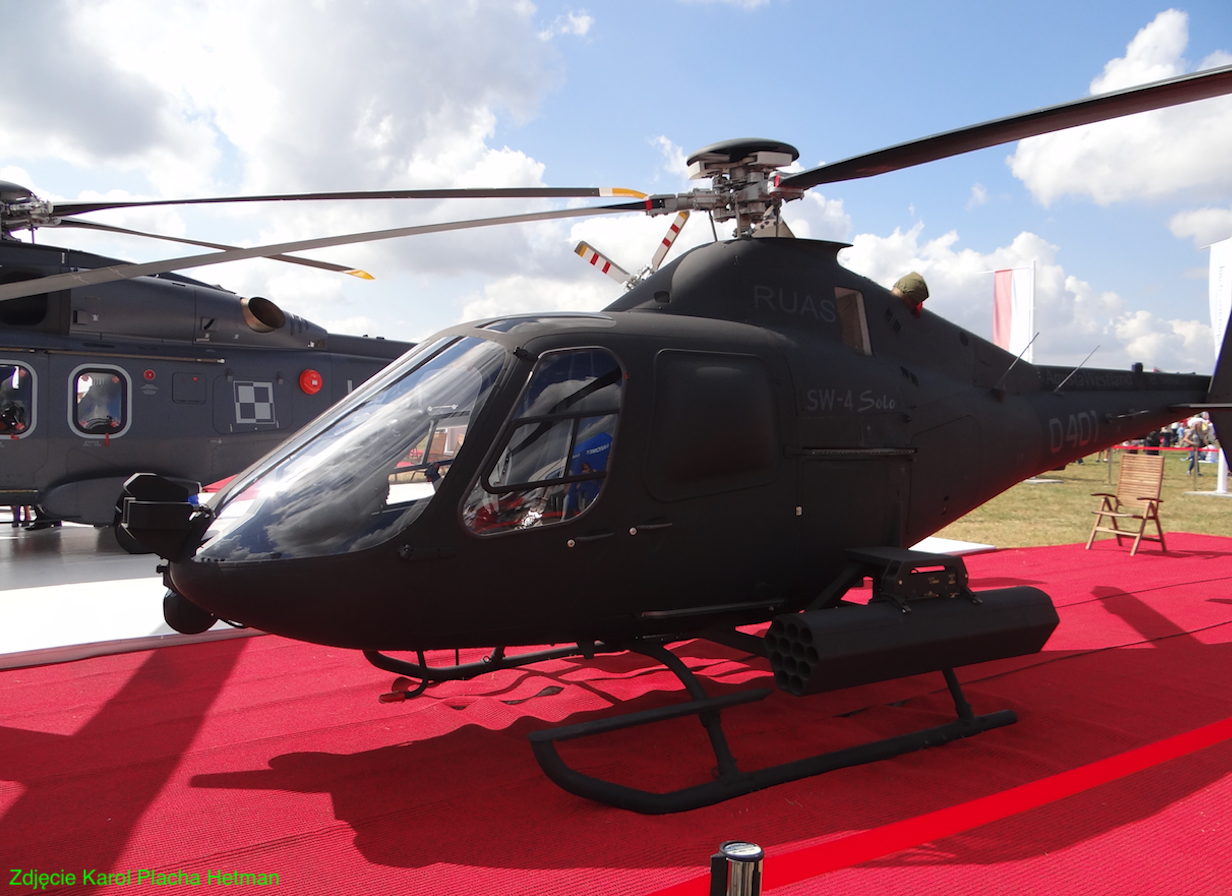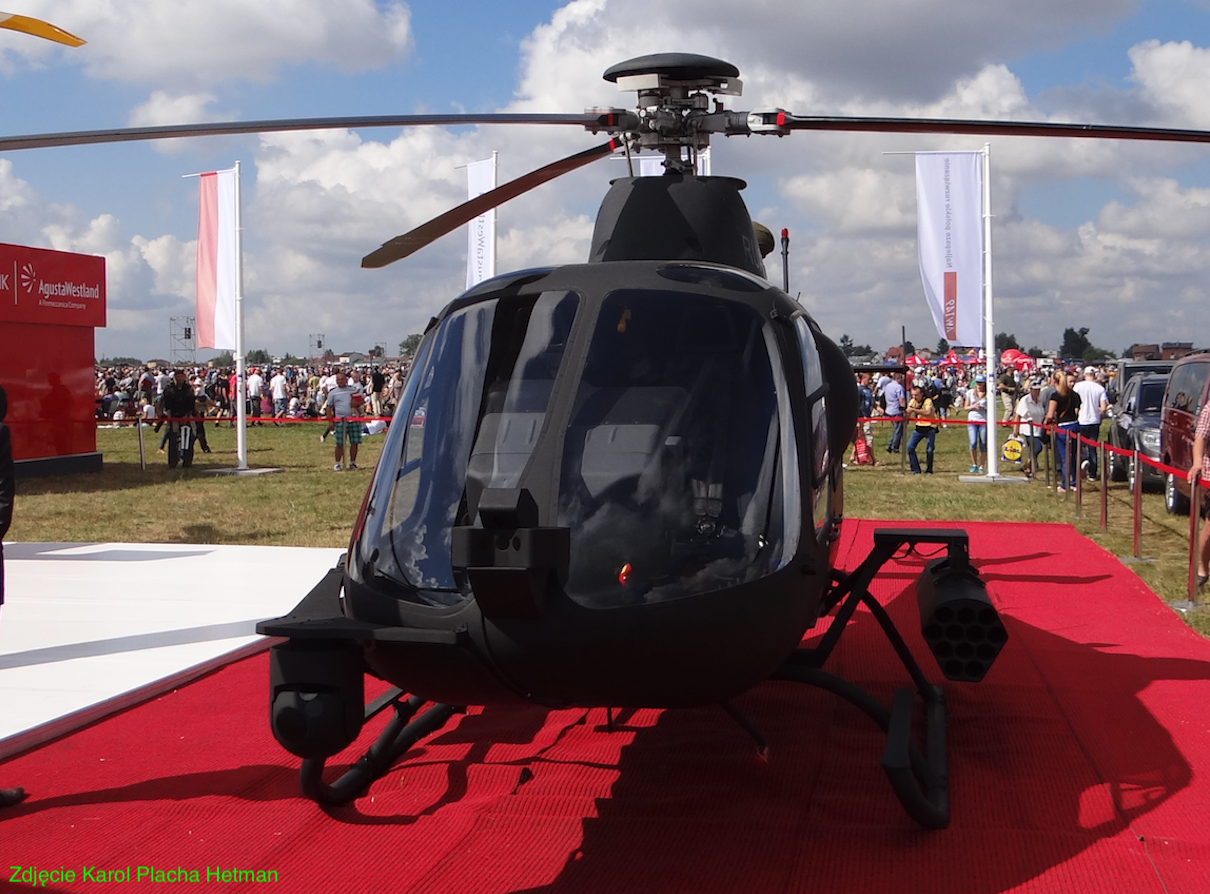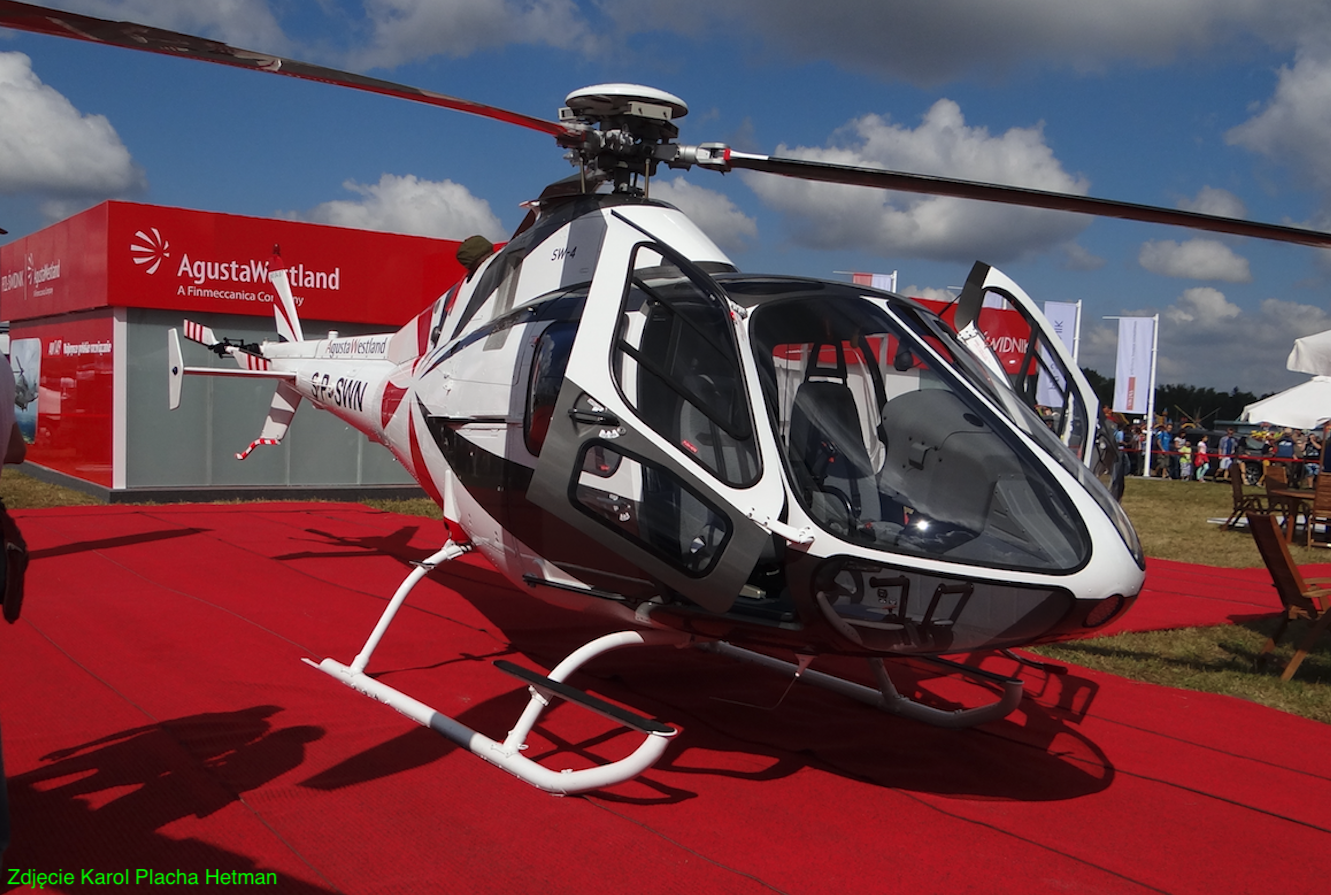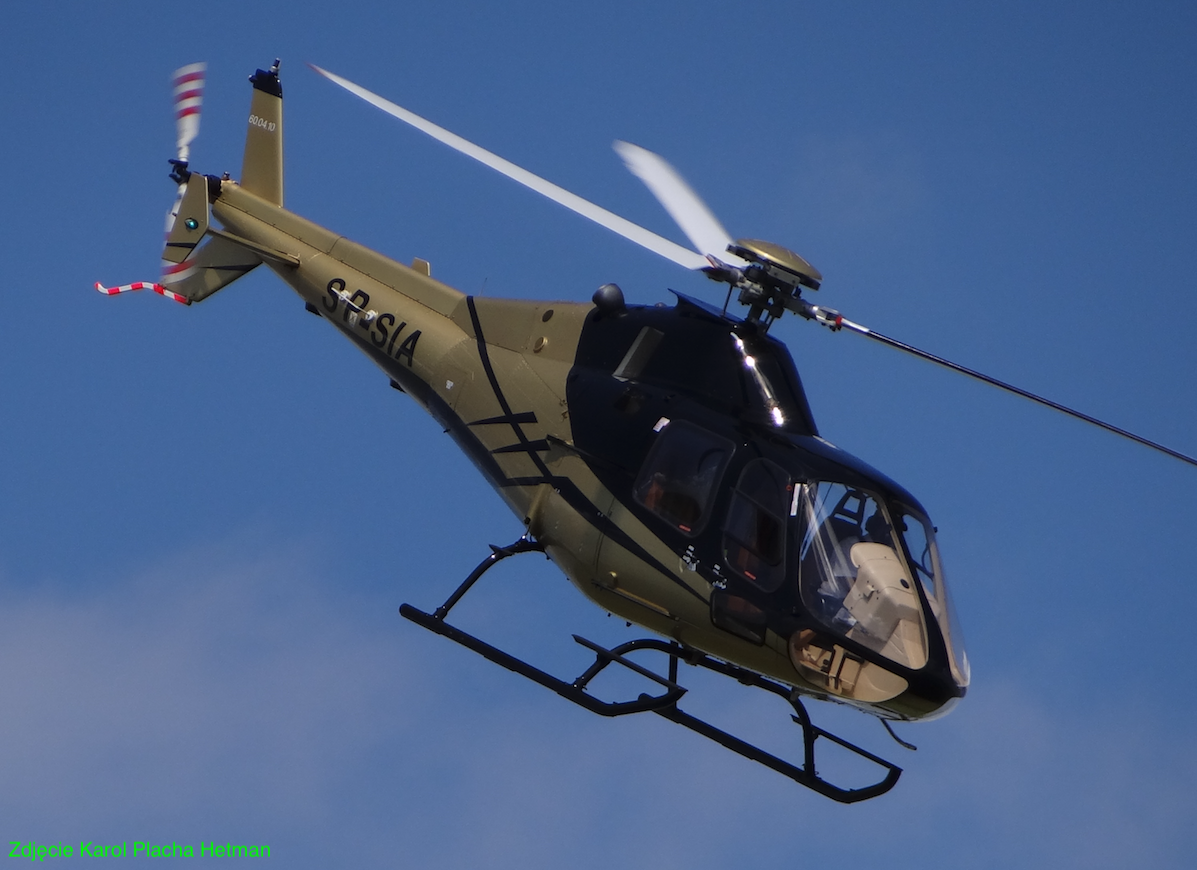Warszawa 2018-05-12
PZL Świdnik SW-4 Puszczyk.
290b Rozdział 26.10.1996 rok.
Dalszy rozwój konstrukcji.
SW-4 RUAS/OPH.
Wersja z oznaczeniami RUAS/OPH oznacza dokładnie: RUAS – Śmigłowcowy Bezzałogowy System Powietrzny (Rotorcraft Unmanned Air System); OPH – Opcjonalnie Pilotowany Śmigłowiec (Optionally Piloted Helicopter).
Po przejęciu w 2010 roku, PZL Świdnik przez firmę AgustaWestland rozpoczęto prace nad budową bezzałogowej wersji SW-4. Demonstrator zaprezentowano po raz pierwszy na MSPO 2012 oraz MSPO 2013 w Kielcach. Wariant bezzałogowy został oznaczony jako SW-4 RUAS/OPH i wyposażony w układ zdalnego sterowania, dzięki czemu śmigłowiec może zostać wykorzystany do monitoringu środowiskowego, badania terenu skażonego i oceny skutków klęsk żywiołowych. Ponadto układ automatyczny może zostać całkowicie odłączony od układu sterowania maszyną i wówczas śmigłowiec jest pilotowany przez pilota będącego na pokładzie. Wariant bezzałogowy opracowany wspólnie przez PZL Świdnik i włosko-brytyjski koncern AgustaWestland w oparciu o podstawową wersję śmigłowca SW-4, znajdującego się na wyposażeniu Sił Powietrznych RP. PZL SW-4 Solo RUAS/OPH jako maszyny opcjonalnie pilotowanej fizycznie przez pilota znacznie zwiększa elastyczność zastosowań. Może on między innymi służyć do takich działań jak: transport personelu, prowadzenie rozpoznania, wywiadu oraz nadzoru, przenoszenia zaopatrzenia, uzbrojenia, systemów obserwacyjnych, czy łączności.
Śmigłowiec SW-4 RUAS/OPH był prezentowany w UK, gdzie przeszedł testy symulowanego, automatycznego lądowania na okręcie. „Okrętem” była platforma ciągniona przez ciągnik siodłowy. Testy i prezentacja wypadły bardzo dobrze. Program był realizowany dla Królewskiej Marynarki Wojennej. W ramach programu przeprowadzono 27 godzin lotów demonstracyjnych oraz 22 symulacje automatycznego lądowania na pokładzie okrętu przy wykorzystaniu śmigłowca SW-4 RUAS Solo. Przeprowadzone w ramach kontraktu próby w locie odbyły się na lotnisku w Llanbedr.
SW-4 Solo.
W dniu 15 grudnia 2016 roku, rozpoczęto próby nowej wersji śmigłowca SW-4, która otrzymała oznaczenie SW-4 Solo. Jest to odmiana śmigłowca zarówno bezzałogowego jak i załogowego. Próby miały na celu sprawdzenie funkcjonowania śmigłowca w skrajnych warunkach lotu. Jak informuje oświadczenie prasowe koncernu obronno-lotniczego Leonardo-Finmeccanica, seria testów bezzałogowego śmigłowca SW-4 Solo była prowadzona we współpracy ze spółką DTA (Distretto Tecnologico Aerospaziale Pugliese) i Włoski Urząd Lotnictwa Cywilnego (ENAC, Ente Nazionale Aviazione Civile) przez kilka pierwszych miesięcy 2017 roku – wśród głównych celów testów było sprawdzenie procedur i przepisów dla wykorzystywania tego typu maszyn. Prowadzone testy miały na celu sprawdzenie zdatności śmigłowca do służby we Włoszech.
Warianty SW-4.
Wariant pasażerski przystosowany do przewozu pilota i czterech pasażerów.
Wariant pasażersko-towarowy tak zwany kombi. Maksymalnie zabiera na pokład pilota i 450 kg ładunku lub czterech pasażerów. Ładunek umieszczony jest także w bagażniku. Fotele dla pasażerów są łatwo demontowane i są mniej wygodne niż w wersji pasażerskiej.
Wariant przeciwpożarowy ze zbiornikiem SEI Bambi 1012, o pojemności 455 litrów i masie własnej 39 kg, który podwiesza się pod kadłubem. Wartość takiej maszyny pożarniczej jest jednak symboliczna i może tylko wspomagać zasadnicze środki walki z pożarem.
Wariant szkolny z podwójnymi sterownicami.
Wariant medyczny z jednym chorym na noszach, pilotem i ratownikiem medycznym. Na pokładzie ma być sprzęt medyczny, butla tlenowa z osprzętem, defibrylator, podłoga antypoślizgowa i odporna na zabrudzenia, system łączności wewnętrznej i zewnętrznej, wciągarka o udźwigu 150 kg.
Wariant policyjny z odpowiednim wyposażeniem (kamera do zdjęć w podczerwieni, noktowizor, kamera klasyczna, system łączności, wyciągarka itp.).
Wariant wojskowy dla Polskich Sił Powietrznych to PZL SW-4 Puszczyk.
Chiny.
Jedno jest pewne; W dniu 30 grudnia 2008 roku, śmigłowiec PZL SW-4 otrzymał świadectwo nadane przez chiński nadzór lotnictwa cywilnego. Reszta to świat domysłów i przypuszczeń. W 2007 roku, PZL Świdnik podpisało umowę z Chinami dotyczącą montażu śmigłowców w nowo budowanym zakładzie Tianyi Helicopter Xinjiang Airlines Company w specjalnej strefie rozwojowej prowincji Jiangxi. Zakładała ona złożenie 150 śmigłowców PZL SW-4 Puszczyk, PZL W-3 Sokół oraz PZL Kania w okresie 2007-2014. W dniu 25 lutego 2010 roku, źródła chińskie podały, że w Nanchang Changbei International Airport nastąpił oblot pierwszego zmontowanego w Chinach śmigłowca SW-4. Według ich źródeł montaż odbył się w Zakładach Produkcji Lotniczej Czerwony Orzeł w Jiujiang z elementów dostarczonych z Polski. Natomiast firma PZL Świdnik nie potwierdził informacji, że śmigłowce PZL SW-4 montowane są w Chinach. Możliwe jest, że umowa została przez stronę chińska zerwana i Chiny przystąpiły do produkcji bez licencyjnej kopi śmigłowca SW-4, co w tym kraju zdarzało się wielokrotnie, aby nie napisać, iż była to norma.
W 2016 roku, do Chin sprzedano partię 10 maszyn SW-4.
SW-4 / AW.009.
W marcu 2016 roku, podczas targów Heli Expo w w Louisville w stanie Kentucky w USA firma Finmeccanica Helicopter Division zademonstrowała cywilną wersję rozwojową śmigłowca SW-4 pod nowym oznaczeniem AW.009. Według materiałów reklamowych nowy śmigłowiec zapewnia lepszy poziom komfortu podczas lotu, niższe koszty utrzymania i użytkowania. W wirniku nośnym zastosowano skuteczniejszy system tłumienia drgań. Nowa wersja wyposażona jest też w nowy, zintegrowany system awioniki, z zainstalowanym wyświetlaczem wielofunkcyjnym awioniki firmy Genesys.
Śmigłowiec SW-4 w zależności od życzeń zamawiającego może być wyposażony w nadmuchiwane pływaki ratunkowe oraz gilotynę nad kabiną, do cięcia przewodów napowietrznych w sytuacji awaryjnej.
W przyszłości oferowana będzie również opcja zainstalowania mocniejszego silnika. Producent podpisał porozumienie o współpracy z firmą AAL USA z Huntsville w stanie Alabama w sprawie integracji awioniki oraz uzyskania certyfikatu FAA, oczekiwanej do końca 2016 roku.
Śmigłowiec AW.009 jest dedykowany dla realizacji misji szkoleniowych, z zakresu utrzymywania porządku i bezpieczeństwa publicznego, ratownictwa medycznego oraz transportu pasażerów. Finmeccanica Helicopter Division otrzymała list intencyjny wyrażający wstępne zainteresowanie śmigłowcem z Wydziału Policji z Riverside w Kalifornii.
Firma Finmeccanica Helicopter, a teraz Leonardo zamierza wyposażyć śmigłowiec SW-4 w nowy, wydajniejszy i lżejszy wirnik nośny.
Eksploatacja.
Rezultaty handlowe sprzedaży SW-4 nie są duże. Nie można było mówić o podboju światowego rynku. Jednak maszyna jest już dobrze rozpoznawalna na świecie i ma za sobą sporo pozytywnych argumentów. SW-4 pochodzi z fabryki, która w ciągu sześćdziesięciu lat zbudowała około 7 000 śmigłowców. Posiada silnik i awionikę Zachodnią. Ma wszystkie najważniejsze certyfikaty świata. Była testowana w USA, Włoszech, UK, Korei Południowej, Brazylii i państwie moskiewskim. Śmigłowiec jest eksploatowany w kraju producenta, co jest bardzo ważne.
Śmigłowce SW-4 w cywilnych wersjach są eksploatowane w Polsce, Chinach, Korei Południowej, Ukrainie, Brazylii, Włoszech. Do 2015 roku, wyeksportowano 16 śmigłowców w cywilnych wersjach. W 2016 roku, do Chin sprzedano partię 10 maszyn SW-4.
Niskie koszty utrzymania i eksploatacji śmigłowca oraz prosta obsługa spowodowały, że SW-4 jest jednym z popularniejszych już śmigłowców użytkowanych prywatnie. Cena wersji podstawowej wynosi od 750 tys. do 1 mln. zł.
Według dostępnych informacji śmigłowce SW-4 do 2018 roku uległy sześciu wypadkom. Co istotne nikt nie zginął, a poszkodowani mieli jedynie niewielkie obrażenia. Jeden wypadek wydarzył się w USA w porcie lotniczym Fairbanks na Alasce. W dniu 15 stycznia 2012 roku uległ rozbiciu podczas testów w niskich temperaturach (-38 stopni), nr rej. SP-SSW, nr ser. 60.04.01. Drugi wypadek był w Korei Południowej. W dniu 6 lutego 2012 roku doszło do bardzo twardego lądowania. Nr rej. HL9403 nr ser. 60.03.21. Trzeci wypadek w Chinach w dniu 16 czerwca 2013 roku. Śmigłowiec podobno był zmontowany w Chinach.
W Polsce w Dęblinie wydarzyły się trzy wypadki. Pierwszy w dniu 3 kwietnia 2007 roku, kiedy to podczas szkolenia w auto-rotacyjnym lądowaniu, przeciążona łopata wirnika nośnego uderzyła w belkę ogonową. W dniu 6 czerwca 2013 roku podczas awaryjnego lądowania maszyna przewróciła się na bok. Trzeci i ostatni wypadek wydarzył się w dniu 13 grudnia 2017 roku. Podczas lądowania maszyna przewróciła się na bok. W komunikacie wydanym przez Ministerstwo Obrony Narodowej oraz Dowództwo Generalne Rodzajów Sił Zbrojnych poinformowano, że do zdarzenia doszło w godzinach wieczornych, w trakcie wykonywania lotu szkolnego. Podczas lądowania śmigłowca poszkodowani zostali dwaj znajdujący się na pokładzie piloci. Lotniskowe służby ratownicze udzieliły im pierwszej pomocy i zabezpieczyły miejsce zdarzenia. Piloci zostali przetransportowani do szpitala. Ich życiu nie zagrażało niebezpieczeństwo.
Opracował Karol Placha Hetman




